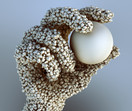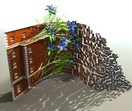Winners
The Computer Graphics Forum 2010 Cover Image has been selected by the CGF editorial board. We thanks all people who submitted this year, and hope that they will participate to the next year contest.
Winner of the Computer Graphics Forum 2010 Cover Image Contest

Adrien Peytavie (1), Eric Galin (1), Stéphane Mérillou (2) and Jérome Grosjean (3)
(1) LIRIS, Lyon University, France
(2) XLIM, Limoges University, France
(3) LSIIT, Strasbourg University, France
A grasping hand made of small stones.
This complex model, featuring 17 504 stones (2,315,840 triangles), was automatically created from a simple mesh model. We use an aperiodic tiling method for generating the stones into contact without any computationally demanding physically-based simulation. Our approach relies on a modified corner cube algorithm to generate a set of aperiodic tiles, which enables us to avoid visually disturbing repetitive patterns.
Our model allow us to control the shape as well as the relative orientation and size distribution of the stones.
Second place:

Lars Krecklau, Darko Pavic and Leif Kobbelt
RWTH-Aachen University, Germany
The image is created by a procedural modeling technique that uses multiple non-terminal classes. This enables us to create different types of objects within a unified modeling framework, for instance combining architectural and organic structures. The scene is completely described by a small rule set which automatically creates the high amount of detail. Even the stones on the wall are unicolored geometric objects which use a random variation in their color value for a more realistic overall impression. Therefore, the scene does not need to contain any textures. Architectural structures are generated by successively splitting boxes along one of its local axes whereas the simulation of a plant growth benefits from trilinear free form deformation. The breaking wall on the right side of the image also uses the idea of a growth process using a sine wave as basic function. The final rendering with ambient occlusion, soft shadows and bloom effect on the highlights was done in Blender.
Third place:

Toon Lenaerts and Philip Dutré
Katholieke Universiteit Leuven
This image is a frame from an animation showing a dancing woman wearing a dress made of red paint. The full animation can be seen at http://www.youtube.com/watch?v=-PvoACGXsYI.
This animation was produced by our own particle-based simulator which is capable of combining a fluid simulation and a cloth simulation at once. Hence, the dress moves as a cloth and splashes as a fluid.
The scene was rendered using POV-Ray.
